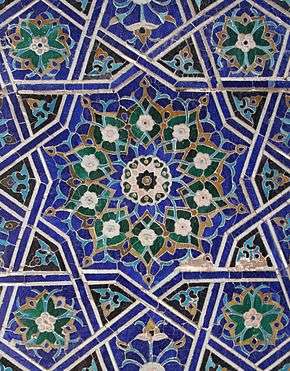Museum of Islamic Art, Cairo
|
Museum of Islamic Art, in central Cairo, Egypt | |
| Established | 1858 |
|---|---|
| Location | Cairo |
| Website | http://www.islamicmuseum.gov.eg |
The Museum of Islamic Art, in Cairo, Egypt, is considered one of the greatest in the world, with its exceptional collection of rare woodwork and plaster artefacts, as well as metal, ceramic, glass, crystal, and textile objects of all periods, from all over the Islamic world.
In recent years, the museum has displayed about 2,500 artefacts in 25 galleries,[1] but it houses more than 102,000 objects, with the remainder in storage. The collection includes rare manuscripts of the Qur'an, with some calligraphy written in silver ink, on pages with elaborate borders.
The Museum has conducted archaeological excavations in the Fustat area and has organized a number of national and international exhibitions. The museum closed for renovations in 2003, and re-opened 8 years later, in August 2010.[1] The restoration cost nearly US$10 million.[1]
History
Although recognition of Pharonic art was signaled in Cairo by the establishment in 1858 of the Department of Antiquities and the Egyptian Museum, the appreciation of Arab and Islamic Art lagged behind. The Khedive Ismail approved a proposal to establish a Museum of Arab Art in the Courtyard of the Mosque of Baibars, but this was not carried out until 1880, when Khedive Tawfiq ordered the Ministry of Endowments (ar: الأوقاف - Awqaf) to set it up.
Julius Franz, an Austrian Scholar of Hungarian Descent, the Head of the Technical department at the Awqaf, proposed in 1881 that the ruined Mosque of the Fatimid Caliph al-Hakim, adjacent to the Bab Al-Futuh, to be a provisional seat for the Museum. A Gallery was accordingly furnished there in the eastern arcade, consisting initially of 111 architectural pieces taken from other Monuments.
Matters improved the same year when Khedive Tawfiq approved the "Committee of Arab Antiquities", whose duties included running the Arab Museum, and providing it with objects as well as preserving the monuments. As a result, the arcades of the mosque were filled to overflowing. In 1884, a two-storey structure was built in the courtyard to house the collection of 900 objects, although its staff consisted of only one curator and a door keeper.
In 1887 Max Hertz, also Austro-Hungarian, replaced Julius Franz, and began making many changes. He suggested the name of the Museum back then as the gallery of Arab Antiquities (ar: دار الآثار العربية - Dar Al-Athar Al-Arabiya). By 1895 the collection numbered to 1,641, and the new building became too crowded, so he requested the Awqaf to build a larger Museum. In 1899 the foundations were laid for the present larger building in the Bab Al-Khalq area of Cairo.
The new and current building was designed by Alfonso Manescalo, and was completed in 1902 in neo-Mamluk style, with its upper storey housing the National Library. The old museum in al Hakim was demolished in the 1970s, during refurbishment of the mosque there.
Design
The Museum entirely faces Historic Cairo. It has two entrances; one on the north-eastern side and the other on the south-eastern side. A beautiful garden with a fountain once led to the first entrance but was later removed. The entrance on Port Said Street features a very luxurious facade, rich with decorations and recesses inspired by Islamic architecture in Egypt from various periods. The Museum is a two-storey building; the lower floor contains the exhibition halls and the upper floor contains the general stores. The basement contains a store connected with the Restoration Section.
Damage due to bomb blast in 2014
On January 24, 2014 a car bomb attack targeting the Cairo police headquarters on the other side of the street caused considerable damage to the museum and destroyed many artifacts. It's estimated that 20-30% of the artifacts will need restoration. The blast also severely damaged the buildings facade, erasing intricate designs in the Islamic style. The Egyptian National Library and Archives in the same building was also affected.[2][3][4]
References
- 1 2 3 "Largest Islamic art museum reopens after 8 years", CBC News, August 14, 2010, webpage: CBC-14.
- ↑ http://news.nationalgeographic.com/news/2014/01/140124-cairo-egypt-museum-islamic-art-bomb-artifacts-destroyed/
- ↑ http://www.bbc.co.uk/news/world-middle-east-25877201
- ↑ http://www.theguardian.com/world/2014/jan/26/unesco-islamic-museum-cairo-blast
External links
- official Museum of Islamic Art website
- Al Ahram article: Museum of Islamic Art
- AFP article on the Museum of Islamic Art reopening
| Wikimedia Commons has media related to Museum of Islamic Art, Cairo. |
Coordinates: 30°03′N 31°22′E / 30.050°N 31.367°E
